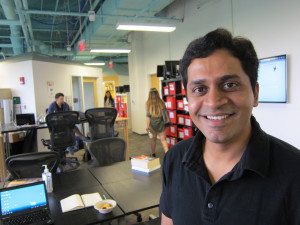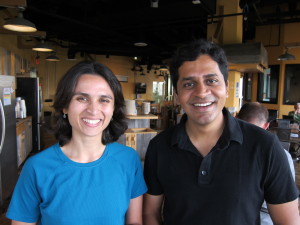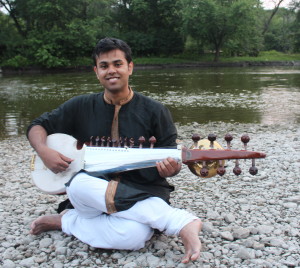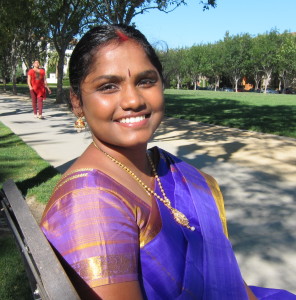By Sharon Simonson

CAMBRIDGE, Mass., FREMONT and SAN JOSE, Calif.—Sriram Emani has no home in Cambridge, Mass., where his two-year-old company IndianRaga is based—or anywhere else for that matter. He travels so much he doesn’t need one. Emani must move fast. He is trying to ignite a global revolution.
From the sparks of the most-promising Indian and Western musicians he can find, the Mumbai-born, MIT-educated entrepreneur is re-inventing Indian classical music for a mass audience. With an emphasis on education in the classic art, his digital-media startup nurtures young talent with peer-to-peer and collaborative learning. At the same time, Emani is searching for ways to distill an ancient art’s hours-long presentation into minutes of 21st-century sound, making the music relevant to a wider, global audience.
![]() Through annual two-week fellowships and more frequent, shorter, smaller labs, IndianRaga has worked with 500 musicians in the last year in 22 U.S., Canadian and Indian cities including San Francisco and San Jose; New York, Los Angeles and Toronto; Chennai, Bangalore and Pune. “We are looking for the big stars and the big outliers that could be the next big thing for Indian music,” Emani said.
Through annual two-week fellowships and more frequent, shorter, smaller labs, IndianRaga has worked with 500 musicians in the last year in 22 U.S., Canadian and Indian cities including San Francisco and San Jose; New York, Los Angeles and Toronto; Chennai, Bangalore and Pune. “We are looking for the big stars and the big outliers that could be the next big thing for Indian music,” Emani said.
He is now seeking to raise $500,000 from a handful of investors who bring connections and relevant knowhow. Emani believes that IndianRaga could generate more than $1 billion a year in sales, just to start.

According to the World Bank, India’s 1.3 billion people enjoy rising incomes, education levels and life expectancy. Beyond that, nearly 30 million Indians and people of Indian descent live outside the country. The largest portion—4.5 million people—lives in the United States, according to the Ministry of Overseas Indian Affairs. U.S. Asian-Indian households enjoy median income of more than $100,000 a year, nearly twice the U.S. household income overall, according to the Census Bureau’s 2013 American Community Survey.
In the beginning, IndianRaga focused on uniting North Indian and South Indian classical music. The traditions historically have been very separate, with musicians even specializing within each category. The music’s trajectory shifted during the 2014 Fellowship after a three-hour jam session with Western musicians from New York’s Juilliard School, said Souryadeep Bhattacharyya. The semi-professional sarod player from India who is earning his doctorate in chemical engineering at Georgia Institute of Technology in Atlanta was a 2014 IndianRaga fellow and a mentor to the 2015 fellowship class. The Juilliard and IndianRaga musicians, he said, “hit it off in a big way.”

For the 2015 Fellowship this summer in Chicago, Emani focused on inviting musicians with expertise in Eastern and Western instruments, and more barriers fell away. The result, Bhattacharyya said, “is cool, innovative music.” One creation, “Raga Games Mash-up,” features a jazz saxophone, cymbals and piano alongside the twang-y Hindustani sarod, a sort of Indian guitar, the tabla and mridangam, hand drums of the North Indian Hindustani and South Indian Carnatic traditions respectively.
Like jazz, Indian classical music is highly improvisational. A raga is a series of no more than seven notes forming a melody that is the base for improvisation. The same raga can be improvised upon in practically infinite ways. In Sanskrit, the word means color.
At 5 minutes, 44 seconds, “Raga Games” relies on snippets (ragas, one might say) of the most-known melodies from the theme songs for the movie “Pirates of the Caribbean,” HBO’s “Game of Thrones,” and the 1963 Henry Mancini mega-hit for the Pink Panther movies and cartoon franchise. Interwoven are improvised vocals from a male Carnatic singer, Indian hand drums, flute and violin. The song is alive with new sounds and emotion. Should a talented American-style rock ’n’ roller come along, he’d happily orchestrate a similar session, Emani said.
(Recording of “Raga Games Mashup” courtesy of IndianRaga)
Sixteen-year-old mridangam player Aditya Sriram was one of the musicians who helped create “Raga Games Mash-up.” Born in Texas, he moved with his family to Fremont, Calif., at age two. The town of 215,000 people is 20 percent Asian Indian. Before he was five years old, he started to play piano. At six or seven, his musical interest expanded to the Western drums after he saw a video featuring the 1970s British rock group Queen. Four years ago, he began to play the mridangam.
His friends won’t tolerate Indian classical music, Aditya Sriram said, but the Irvington High School senior thinks they would take to IndianRaga’s latest work. “It’s a new sound that is surprisingly really good,” he said. “I think we are at the beginning of a new genre that has the potential to be huge.”![]()
Emani has talked for years about bringing Indian music to the world, said Vivek Upadhyay, who has known him since the two were teenagers attending the Indian Institute of Technology in Mumbai. The London-based high-frequency stock trader knew his friend was serious about pursuing his dream when Emani relinquished a high-paying international business-management consulting job two years after college to return to Mumbai to work for the National Centre for the Performing Arts. The center is India’s premier cultural and arts institution working to preserve and improve the country’s music, dance, theater, film, literature and photography.

In December, he told Emani that if IndianRaga partnered with investors, he wanted to be one. Emani, unlike many of his other entrepreneurial college friends, had never asked him for money, but the choice seemed obvious, Upadhyay said: “This is the only company that is generating revenue.”
Earning a master’s of business administration in 2014 from the Massachusetts Institute of Technology (one of the top three best universities in the world, according to The Economist) is one of a very long list of Emani accomplishments. While at MIT, he earned competitive scholarships. He has worked with the president of New York’s Lincoln Center for the Performing Arts and the president of Global Digital Business for Sony Music, New York. In 2012 IndianRaga was recognized as a winner in the MIT IDEAS Global Challenge, a competition run by the school’s Public Service Center to recognize social entrepreneurship and innovation. The list goes on.
A rival might slip into envious dislike, but Emani is so unpretentious that he seems impossible to shun. Where others might be expected to express frustration or irritation, he displays none. A trained Indian classical musician himself, Emani says the musical talents of the IndianRaga fellows far outstrip his own. But musicians who have worked with him say his energy and skill evoke awe.
“He is a brilliant leader,” said NCS Ravali, another 2015 IndianRaga fellow now living in San Jose. The 28-year-old Carnatic singer grew up in Hyderabad and studied music from childhood. She moved to the United States in 2013—first to New Jersey, then to Silicon Valley—after marrying her husband, a Google Inc. systems engineer. The fellowship transformed her understanding of her craft, her profession and herself. “I never thought I could do so many different things,” she said, “and the complete credit goes to Sriram, for making us think and giving us the freedom and a platform to experiment boldly.”
For more information about IndianRaga fellowships and labs: IndianRaga.com
To see videos of IndianRaga musicians: https://www.youtube.com/user/indianragaproject